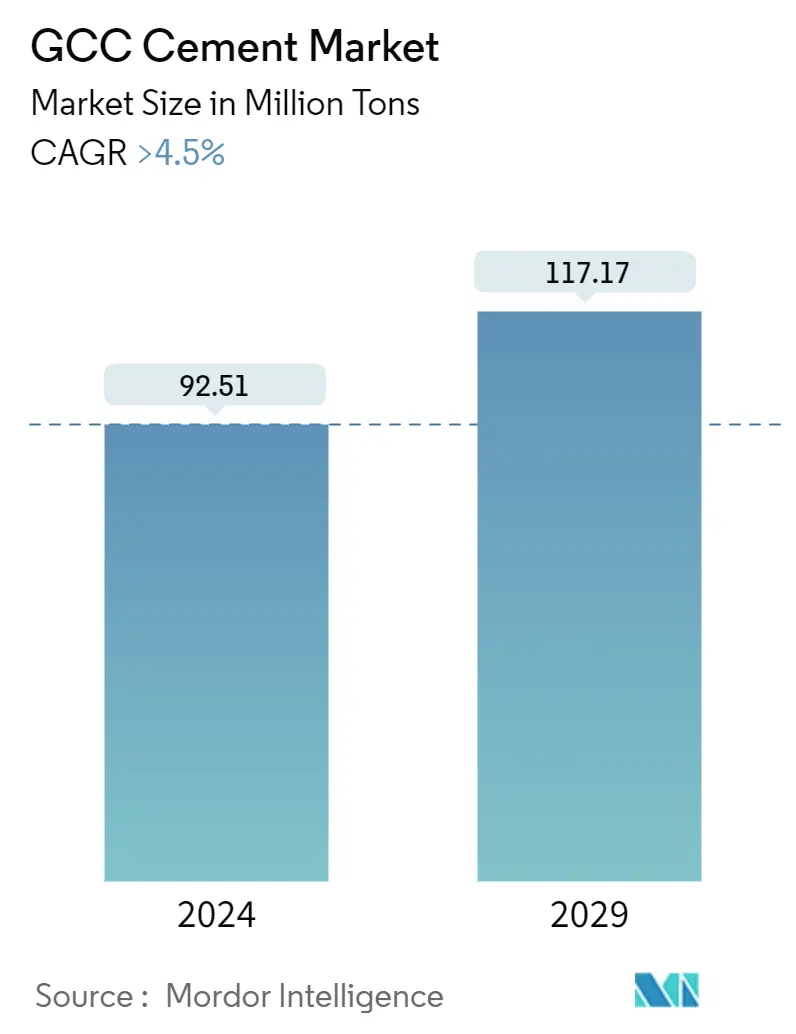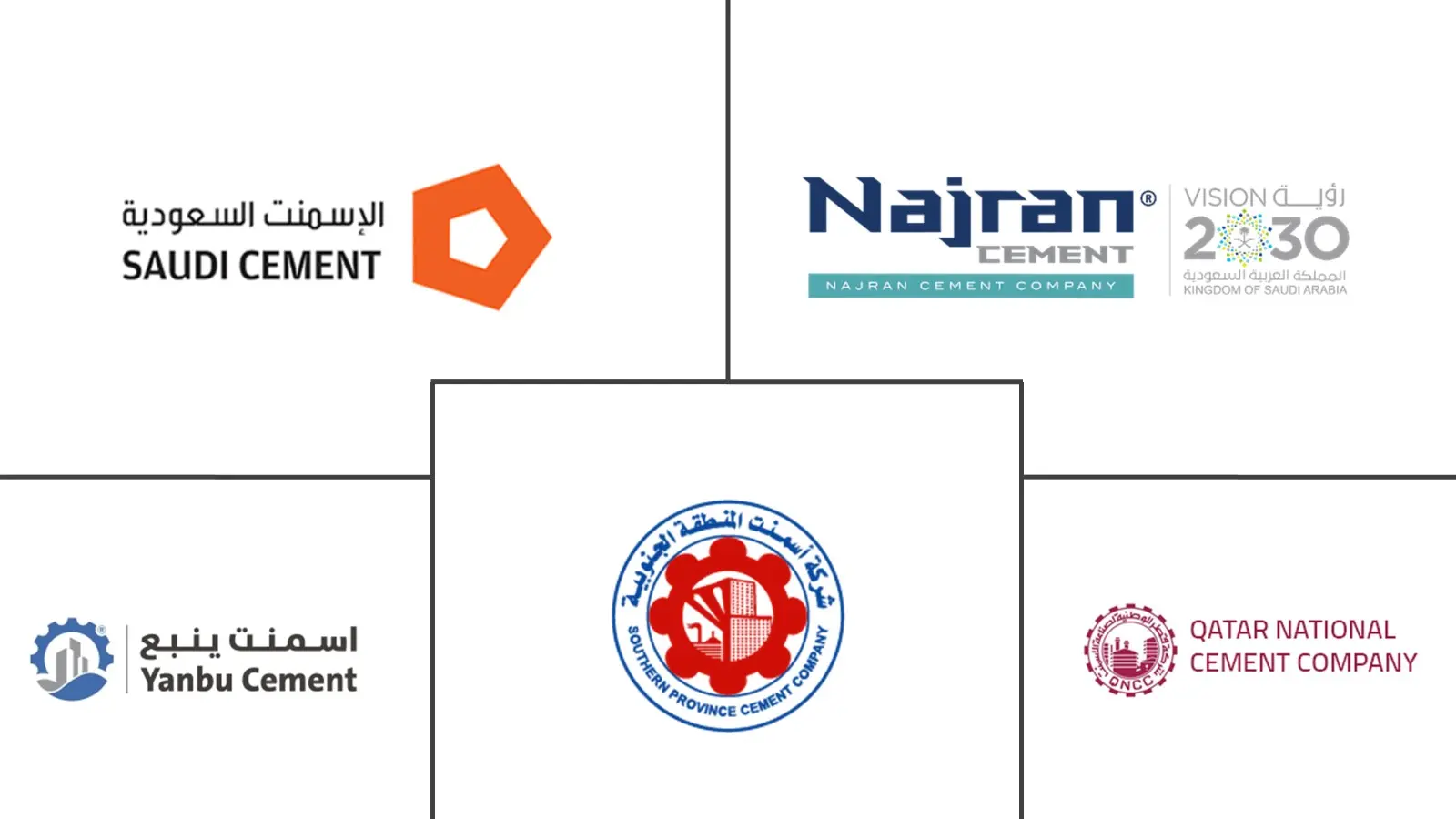Market Size of GCC Cement Industry

| Study Period | 2019 - 2029 |
| Base Year For Estimation | 2023 |
| Market Volume (2024) | 92.51 Million tons |
| Market Volume (2029) | 117.17 Million tons |
| CAGR (2024 - 2029) | > 4.50 % |
| Market Concentration | Medium |
Major Players
*Disclaimer: Major Players sorted in no particular order |
GCC Cement Market Analysis
The GCC Cement Market size is estimated at 92.51 Million tons in 2024, and is expected to reach 117.17 Million tons by 2029, growing at a CAGR of greater than 4.5% during the forecast period (2024-2029).
The GCC cement market was negatively impacted by the COVID-19 pandemic as the nationwide lockdowns in the region resulted in decreasing demand across the construction industry and the closing of various manufacturing facilities. However, post-pandemic, the market is recovering gradually.
- Over the medium term, the increase in regional residential constructions and growing infrastructural activities drive the market's growth.
- On the flip side, government regulations on carbon emissions from cement manufacturing plants are expected to hinder the market's growth.
- However, shifting preference toward green construction will likely act as an opportunity for the market.
- Saudi Arabia dominates the market across the region, with the most substantial consumption from the country's construction industry.
GCC Cement Industry Segmentation
Cement, a crucial building component, is a binding agent that sets and hardens to cling to building units such as stones, bricks, and tiles. It is a fine powdery substance composed primarily of limestone (calcium), sand or clay (silicon), bauxite (aluminum), and iron ore. It may also include shells, chalk, marl, shale, clay, blast furnace slag, and slate.
The GCC cement market is segmented by type, application, and geography. The market is segmented into Portland, blended, and other types (rapid hardening cement, quick setting cement, expansive cement, hydrographic cement, and colored cement). The market is segmented by application into residential, commercial, infrastructure, industrial, and institutional. The report also covers the size and forecasts for the cement market in six regional countries. Market sizing and forecasts were made for each segment based on volume (tons).
| Type | |
| Portland | |
| Blended | |
| Other Types (Rapid Hardening Cement, Quick Setting Cement, Expansive Cement, Hydrographic Cement, and Colored Cement) |
| Application | |
| Residential | |
| Commercial | |
| Infrastructure | |
| Industrial and Institutional |
| Geography | |
| Saudi Arabia | |
| United Arab Emirates | |
| Qatar | |
| Oman | |
| Kuwait | |
| Bahrain |
GCC Cement Market Size Summary
The GCC cement market is poised for growth, driven by increasing residential construction and infrastructural activities in the region. The market, which experienced a downturn due to the COVID-19 pandemic, is on a recovery path, with Saudi Arabia leading the charge as the dominant player. The country's construction industry, a significant consumer of cement, is bolstered by large-scale projects and government initiatives like Vision 2030, which focuses on sustainability and economic diversification. Despite challenges such as stringent carbon emission regulations, the shift towards green construction presents new opportunities for market expansion. The residential sector, in particular, is witnessing a surge in demand, supported by rising disposable incomes and enhanced building standards.
Saudi Arabia's robust construction sector, supported by substantial investments in infrastructure and real estate, is a key driver of the GCC cement market's growth. The country's strategic projects, including the development of mega cities and tourist destinations, are expected to significantly boost cement consumption. The market is characterized by a partial fragmentation, with major players like Southern Region Cement Company and Saudi Cement Company leading the industry. Recent developments, such as the expansion of production capacities and strategic acquisitions, indicate a dynamic market landscape. These factors collectively suggest a positive outlook for the GCC cement market over the forecast period.
GCC Cement Market Size - Table of Contents
-
1. MARKET DYNAMICS
-
1.1 Market Drivers
-
1.1.1 Increase in Residential Constructions Across the Region
-
1.1.2 Growing Infrastructural Activities In The Region
-
1.1.3 Other Drivers
-
-
1.2 Market Restraints
-
1.2.1 Government Regulations On Carbon Emissions From Cement Manufacturing Plants
-
1.2.2 Other Restraints
-
-
1.3 Industry Value Chain Analysis
-
1.4 Porter's Five Forces Analysis
-
1.4.1 Bargaining Power of Supplier
-
1.4.2 Bargaining Power of Buyer
-
1.4.3 Threat of New Entrant
-
1.4.4 Threat of Substitute Products and Services
-
1.4.5 Degree of Competitive
-
-
-
2. MARKET SEGMENTATION (Market Size In Volume)
-
2.1 Type
-
2.1.1 Portland
-
2.1.2 Blended
-
2.1.3 Other Types (Rapid Hardening Cement, Quick Setting Cement, Expansive Cement, Hydrographic Cement, and Colored Cement)
-
-
2.2 Application
-
2.2.1 Residential
-
2.2.2 Commercial
-
2.2.3 Infrastructure
-
2.2.4 Industrial and Institutional
-
-
2.3 Geography
-
2.3.1 Saudi Arabia
-
2.3.2 United Arab Emirates
-
2.3.3 Qatar
-
2.3.4 Oman
-
2.3.5 Kuwait
-
2.3.6 Bahrain
-
-
GCC Cement Market Size FAQs
How big is the GCC Cement Market?
The GCC Cement Market size is expected to reach 92.51 million tons in 2024 and grow at a CAGR of greater than 4.5% to reach 117.17 million tons by 2029.
What is the current GCC Cement Market size?
In 2024, the GCC Cement Market size is expected to reach 92.51 million tons.

